- Strategic marketing aligns long-term business goals with customer insights, market dynamics, and differentiated value propositions.
- Core frameworks like SWOT, PESTLE, Ansoff Matrix, and Porter’s Five Forces guide planning, positioning, and growth decisions.
- Real-world case studies from Apple, Netflix, Kodak, and Blockbuster illustrate how strategy execution determines sustainable success or failure.
Strategic marketing isn’t a trendy buzzword. It’s the backbone of sustainable market leadership. When we build brands or position companies for growth, we aren’t simply choosing what colors to use in a campaign or which social channel to prioritize; we’re solving a long-term business puzzle. Every marketing decision should serve a broader strategic agenda, rooted in market realities and aligned with the company’s core capabilities.
Strategic marketing is about deliberately shaping customer perception, choosing which markets to serve and which to avoid, designing defensible value propositions, and allocating resources in ways that yield sustainable advantage. Tactical wins are important, but they’re fleeting unless backed by strategic direction.

If you’ve ever watched a well-executed product launch feel underwhelming or seen a competitor seize ground because they anticipated a shift in market sentiment, you’ve already felt the weight of strategic gaps. This guide distills everything I’ve learned from two decades of work with Fortune 100 brands and early-stage scaleups about how to turn marketing into a strategic force within your organization.
What Strategic Marketing Actually Means
Strategic marketing is the deliberate alignment of marketing resources and activities with long-term business goals. It requires a clear understanding of market dynamics, customer needs, competitor capabilities, and internal strengths.
While tactical marketing addresses short-term objectives, launching a campaign, optimizing conversion, and generating leads, strategic marketing answers the foundational questions:
- Who are we serving?
- What unique value do we deliver?
- Where can we win long-term?
- How do we adapt to the shifting market?
It connects marketing decisions to business outcomes, such as market share expansion, category leadership, margin growth, and customer lifetime value. And it forces consistency in messaging, positioning, and experience across every channel and touchpoint.
Strategic marketing integrates four big levers:
- Segmentation and Targeting
- Positioning and Differentiation
- Marketing Mix Planning (4Ps/7Ps)
- Organizational and Operational Alignment
Without a strategy, marketing becomes noise. With it, marketing becomes leverage.
Principles and Goals of Strategic Marketing
Let me walk through the five core principles I always bring to any strategic marketing engagement, whether I’m advising a growth-stage SaaS company or restructuring a CPG brand’s GTM model.
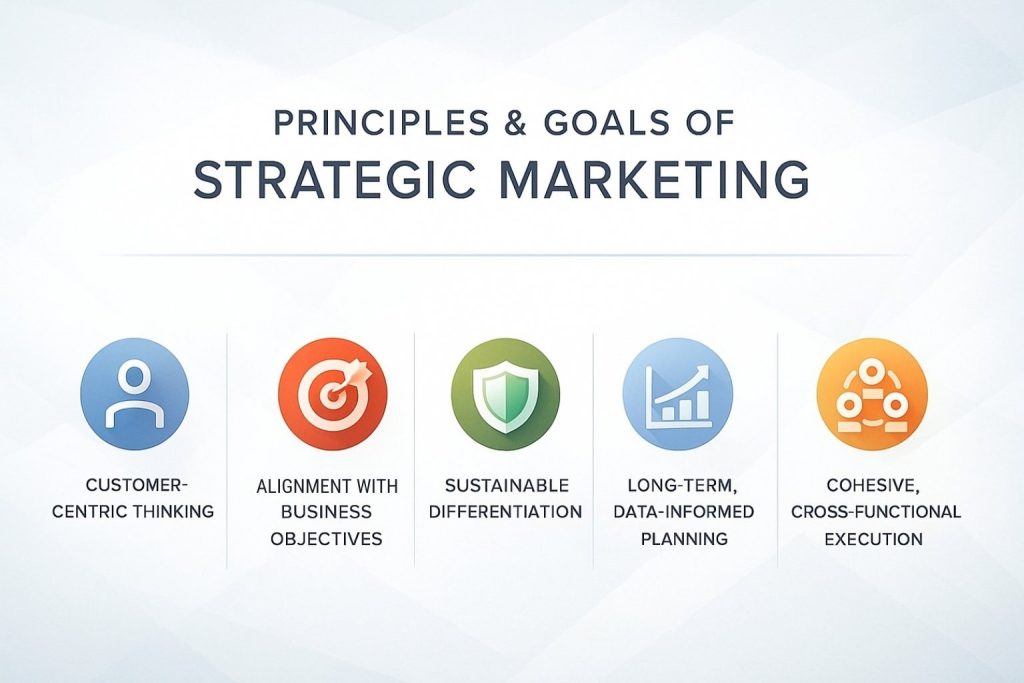
1. Customer-Centric Thinking
A great strategy starts with the customer. Not in the generic “customer is king” sense, but in a truly empathetic, insight-driven way. What do they value? What trade-offs are they willing to make? How are their needs evolving? Strategic marketers obsess over these questions because value is subjective and value creation is the ultimate goal.
We prioritize relevance over reach, and loyalty over clicks.
2. Alignment with Business Objectives
Marketing isn’t a parallel function; it’s a strategic driver of business performance. Every decision we make, from product positioning to pricing tiers to creative narrative, must align with the firm’s strategic objectives.
Whether the business aims for innovation leadership, margin expansion, or vertical diversification, the marketing strategy should accelerate that trajectory, not merely work alongside it.
3. Sustainable Differentiation
We don’t chase fads. We have an engineering advantage. That requires focusing on capabilities and value propositions that are hard to copy, such as technical superiority, network effects, deep customer relationships, proprietary data, and supply chain efficiencies. Then we translate those advantages into a positioning that resonates.
Strategic marketing creates barriers to entry. It’s not just about grabbing attention; it’s about building strategic moats.
4. Long-Term, Data-Informed Planning
We can’t build a strategy on gut feelings or wishful thinking. Every component of strategic marketing, from market selection to product development to brand architecture, must be informed by real data: market size, growth trends, behavioral analytics, margin forecasts, etc.
And strategy isn’t static. Strategic marketers monitor the market relentlessly and refine direction as new threats or opportunities arise.
5. Cohesive, Cross-Functional Execution
Strategic marketing lives or dies by execution. That means uniting product, sales, customer success, ops, and finance around a shared direction. Messaging isn’t owned by marketing alone; it lives in product UX, sales decks, onboarding flows, and support scripts.
Our job is to craft a strategy that others can execute and ensure it’s reinforced at every level.
The Strategic Marketing Frameworks That Actually Work
We’ve all seen more models than we care to count, but the truth is, a few foundational frameworks continue to deliver clarity and structure when used properly. I keep four on heavy rotation: SWOT, PESTLE, Ansoff Matrix, and Porter’s Five Forces. Let’s unpack them.
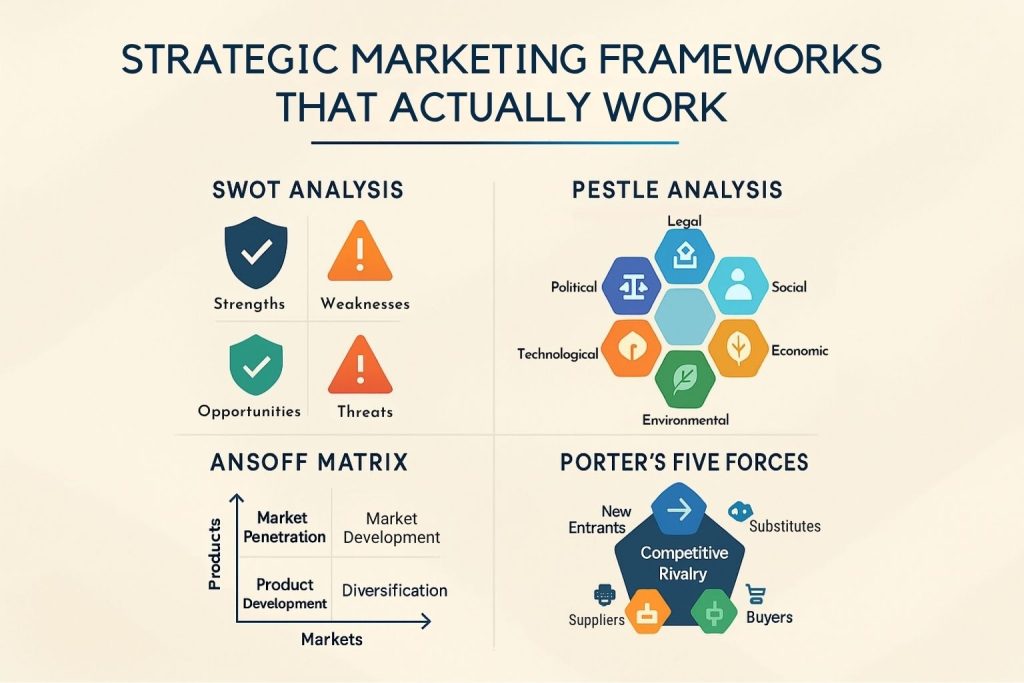
SWOT Analysis: Situational Clarity at Its Best
Used properly, SWOT isn’t just a corporate exercise. It’s an incisive tool to map where we have leverage (strengths), where we’re vulnerable (weaknesses), what’s opening up (opportunities), and what’s closing in (threats).
- Strengths: What are we uniquely good at? What do customers consistently praise?
- Weaknesses: What causes friction in our go-to-market? What do competitors exploit?
- Opportunities: What unmet needs or trends align with our capabilities?
- Threats: What could render our current model obsolete?
The power of SWOT lies in synthesis, using it to generate strategic options, not just diagnostics.
PESTLE Analysis: Scanning the Horizon
Markets don’t operate in a vacuum. PESTLE helps us account for six macro factors that can shift the playing field beneath our feet:
- Political: Trade policies, regulatory changes, election cycles
- Economic: Inflation, interest rates, consumer confidence, employment levels
- Social: Demographic shifts, lifestyle changes, value trends
- Technological: Disruptive innovation, adoption rates, platform shifts
- Legal: Compliance requirements, IP law, labor laws
- Environmental: Sustainability pressures, climate risk, ethical sourcing
We don’t use PESTLE to predict the future. We use it to prepare for it.
Ansoff Matrix: Growth with Eyes Wide Open
This classic framework gives us a strategic lens on growth choices. Every growth path involves different levels of risk. The Ansoff Matrix plots four of them:
- Market Penetration: Sell more to the same customers (least risky).
- Market Development: Enter new markets with existing products.
- Product Development: Create new products for existing customers.
- Diversification: Launch new products in new markets (most risky).
I use this tool in strategic planning sessions to push leadership to articulate not just where we’re growing but how and why.
Porter’s Five Forces: Understanding Industry Pressure
Michael Porter’s framework remains a masterclass in thinking structurally. It answers: Is this market strategically attractive?
The five forces:
- Competitive Rivalry: Are margins under pressure from price wars or saturation?
- Threat of New Entrants: Can new players easily enter and disrupt?
- Bargaining Power of Suppliers: Are we reliant on high-power vendors?
- Bargaining Power of Buyers: Can customers dictate terms or churn easily?
- Threat of Substitutes: Are alternative solutions stealing attention or wallet share?
Every strategic plan needs this analysis. Otherwise, we’re guessing in the dark about competitive intensity and margin pressure.
Strategy Without Execution Is Hallucination
You can develop the most brilliant strategic insight, but if it never gets translated into coordinated action, it’s wasted thinking. In my experience, organizations don’t fail because they don’t have enough ideas; they fail because they don’t know how to focus, operationalize, and adapt.
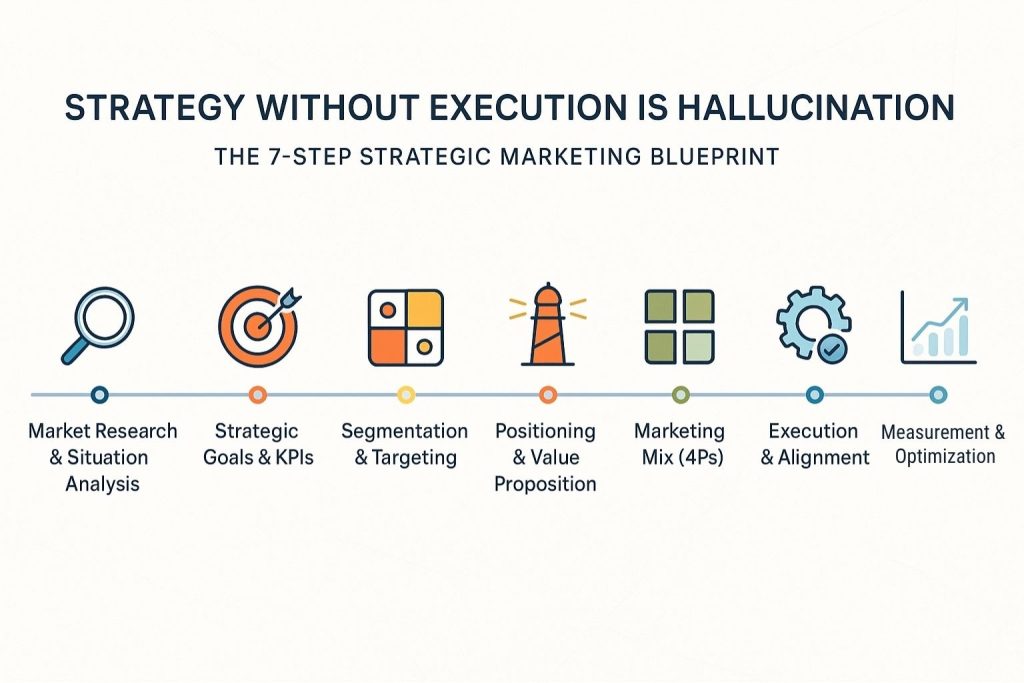
The following seven-step blueprint is how I approach strategic marketing planning and execution in the real world. This structure ensures rigor, alignment, and accountability from initial research through to performance optimization.
Step 1: Market Research and Situation Analysis
We start with facts. This isn’t about guessing customer preferences or relying on internal assumptions. It’s about mapping the real market terrain through deep research.
Key Inputs:
- Quantitative research: Market size, growth forecasts, customer behavior data, sales trends
- Qualitative research: Voice of customer interviews, buyer persona development, observational insights
- Competitive intelligence: Feature matrices, pricing benchmarks, messaging audits
- Internal performance review: Sales conversion rates, retention curves, brand tracking
Tools:
- Use SWOT and PESTLE to interpret both internal capability and external conditions and deeper insight often emerges when you examine how an SEO-focused SWOT highlights hidden strengths and vulnerabilities in organic performance.
- Apply Porter’s Five Forces to evaluate industry attractiveness before committing to major plays.
This phase anchors everything that follows. It’s where clarity is born.
Step 2: Set Strategic Marketing Goals and KPIs
Once we understand where we are, we define where we want to go and how to measure progress.
Key Outputs:
- A small set of SMART goals: Specific, Measurable, Achievable, Relevant, and Time-bound
- Aligned with business strategy: Are we growing revenue, shifting perception, increasing share-of-wallet, or entering a new segment?
- Example goals:
- Increase market share in segment A from 10% to 15% within 18 months
- Grow Net Promoter Score (NPS) from 42 to 55 in one year
- Launch and scale two new SKUs with a 10% conversion rate within six months
Avoid:
- Vague aspirations like “increase awareness”
- Vanity metrics without conversion context
Clarity at this stage builds confidence. Without measurable goals, marketing becomes hard to defend at the executive table.
Step 3: Market Segmentation and Targeting
This is where we shift from “total addressable market” to intentionally chosen segments. Not every customer is worth pursuing. We identify the most attractive and strategically aligned segments, those where we can deliver disproportionate value.
Segmentation Dimensions:
- Demographics: Age, gender, income, education
- Psychographics: Values, interests, attitudes
- Behavioral: Usage frequency, brand loyalty, decision-making styles
- Firmographics (for B2B): Company size, industry, maturity, buying process
Targeting Criteria:
- Profit potential: Size × readiness to buy × LTV
- Strategic fit: Do we have the right capabilities to serve them?
- Competitive saturation: Can we win?
We don’t try to be everything to everyone. We define who we are for, then build laser-focused strategies for them.
Step 4: Positioning and Value Proposition Design
This is where strategy becomes a story.
Our positioning is the mental space we want to occupy in the mind of the target customer. It differentiates us. It gives customers a reason to choose us and to stick around.
Core Questions:
- What unique value do we offer to this customer segment?
- Why is it different and better than alternatives?
- How can we express it clearly, emotionally, and credibly?
I use the classic positioning statement format to pressure-test strategy:
“For [target customer], we are the [category] that [core benefit], because [reason to believe].”
Example:
For young urban professionals, we are the fitness brand that delivers efficient, full-body workouts in 20 minutes, because our science-backed micro-session approach is optimized for busy schedules.
Once this is clear, the value proposition guides messaging, product design, sales conversations, and onboarding.
Step 5: Marketing Mix Strategy (The 4 Ps)
With positioning locked, we activate through the 4 Ps, ensuring each element of the offer aligns with the overall strategy.
1. Product:
- What are we offering and how is it designed?
- Are features aligned with segment needs?
- What level of quality, design, and support do we promise?
2. Price:
- How are we pricing relative to value and competitors?
- Are we signaling premium, affordability, simplicity?
- Do we use subscription, freemium, tiered pricing, or custom quotes?
3. Place (Distribution):
- Where and how will customers access the product?
- Are we direct-to-consumer, retail, marketplace, channel-partner-led?
- Are there gaps in coverage, accessibility, or service?
4. Promotion:
- How do we communicate our message and values?
- What channels are most effective (paid media, content, social, PR, ABM)?
- What mix balances awareness, demand generation, and retention?
Each P needs to reflect and reinforce the core positioning. Misalignment here kills clarity and wastes spend.
Step 6: Execution Planning and Internal Alignment
A strategy without an execution plan is just a dream.
This is where we move from slides to Gantt charts, calendars, roles, and budgets.
Key Elements:
- Tactical workback plans for each campaign or initiative
- Ownership matrix: Who is responsible, accountable, consulted, informed (RACI)
- Cross-functional alignment: Sales, product, ops, and lead are all rowing in the same direction
- Technology stack readiness: CRM, analytics, content systems, automation tools
Pro tip:
Build quarterly sprints with shared marketing OKRs and cross-team dependencies. This creates cadence and accountability, not just big annual plans that collect dust.
Step 7: Measurement, Optimization, and Strategic Feedback Loops
The job doesn’t end at launch. It starts there.
We define a measurement framework tied to the original goals and in many teams, automated workflows play a major role in maintaining consistency across reporting and execution. Then we track KPIs across awareness, engagement, acquisition, retention, and ROI.
Sample Metrics:
- CAC (Customer Acquisition Cost)
- CLV (Customer Lifetime Value)
- ROAS (Return on Ad Spend)
- Funnel conversion rates
- Share of voice
- Brand health trackers
When data reveals underperformance, we don’t panic; we interrogate, iterate, and improve. Strategic marketing is an adaptive discipline.
Strategic Marketing Trends That Matter
Strategic marketing has always been about positioning brands to win in dynamic markets. But in the past two years, the rate of change has accelerated both in terms of tools available and customer expectations. As I work with leadership teams across sectors, I find myself repeating the same line: what worked five years ago is now table stakes or obsolete.
So what’s changing? And how do we bake these trends into strategy, not bolt them on later?
Here’s where I see the landscape shifting and how I’m advising clients to stay ahead.
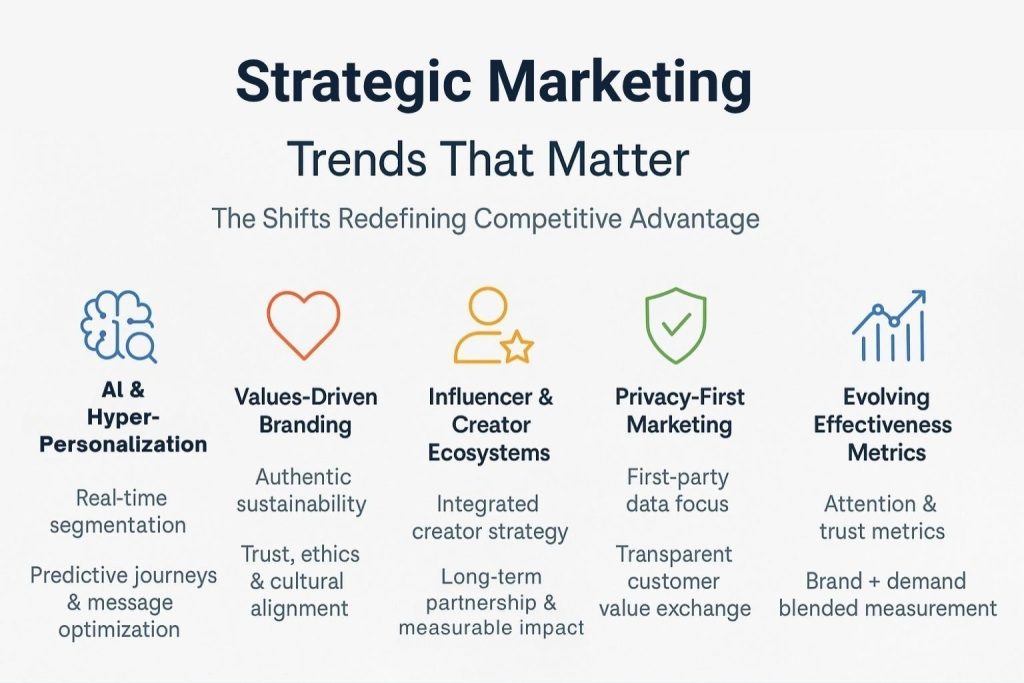
1. AI and Hyper-Personalization Are Reshaping the Strategy Stack
Let’s get one thing straight: AI isn’t just a tactical tool for content creation or chatbot automation. It’s becoming a strategic capability, one that influences how we segment audiences, personalize experiences, and optimize spend.
According to a BCG survey conducted in 2025, 83% of CMOs expressed optimism about the impact of generative AI on their work. Not because it makes copywriting cheaper (though it does), but because it helps us create real-time, data-rich, personalized interactions at scale.
Strategic Implications:
- Audience segmentation is no longer static. AI allows us to cluster, re-cluster, and target based on real-time behavioral signals.
- Message testing and iteration can now happen faster, reducing guesswork in campaigns.
- Customer journeys can be dynamically shaped by predictive models, shifting marketing from reactive to proactive.
But here’s the catch: without a clear positioning strategy, AI simply amplifies noise. It must serve the brand, not override it.
2. Customers Want Brands That Reflect Their Values, or They Walk
We’re past the point where brand purpose was optional. Purpose, ethics, sustainability, and authenticity are now strategic differentiators or strategic risks.
In 2023:
- According to Kantar Marketing 80% of global consumers said they actively try to support brands aligned with causes they care about.
- And nearly two-thirds of customers expected brands to “speak out on issues that matter.”
But performative marketing won’t cut it. Customers now investigate whether your supply chain is ethical, your ad spend is inclusive, and whether your leadership walks the talk.
Strategic Implications:
- Your brand purpose should be codified into your marketing strategy, not left as a vague mission statement.
- Campaign planning must consider cultural sensitivity and social context, especially on polarizing issues.
- Value-driven positioning works only when backed by operational truth; greenwashing or fake DEI efforts backfire.
Marketers have become stewards of corporate reputation. The stakes are real and visible on every platform.
3. Influencer and Creator Ecosystems Are Strategic Channels
Influencer marketing is no longer just a budget line in social media, it’s now a core part of the broader strategic marketing mix across B2C, lifestyle, fashion, gaming, fitness, and emerging categories like web3.
Recent data shows:
- 59.4% of marketers plan to increase their influencer marketing budgets in 2024, according to the Keywordseverywhere Influencer Marketing Stats report.
- According to the CreatorIQ 2024 Influencer Marketing Trends Report landing page, 55% of organizations reported year-over-year increases in influencer-marketing investment.
This growth reflects more than just rising budgets, it signals deeper integration. Top-performing brands embed creators into product co-development, brand storytelling, ongoing content ecosystems, and even customer engagement, moving beyond short-term activations.
Strategic Implications:
- Influencers should align with your brand archetype and values, not just follower count.
- UGC and influencer content should be tracked as part of your attribution model, not left in a silo.
- Long-term partnerships (vs. transactional sponsorships) yield better results, loyalty, and insights.
I advise clients to think of creators as extensions of the brand, not as assets to rent. It changes the way you brief, collaborate, and measure.
4. Privacy-First Strategy Is No Longer Optional
The end of third-party cookies and the rise of global data regulations (GDPR, CCPA, and others) have pushed marketers to rethink how they acquire, store, and use data.
First-party data is now gold. Strategic marketing plans are being rewritten around customer consent, loyalty ecosystems, and transparent value exchange.
Strategic Implications:
- Loyalty programs, gated content, and community-building are now data acquisition tools, not just engagement tactics.
- Customer data platforms (CDPs) are becoming essential infrastructure.
- Transparency and ethical use of data should be part of your brand promise.
We’re moving from “collect everything” to “earn and respect data.” The brands that internalize this shift early will gain customer trust while others scramble.
5. Marketing Effectiveness Is Being Measured Differently
Let me be blunt: click-through rates and impressions are fading. Executives and boards now want to know: What attention are we earning? What impact are we making? What do customers remember, feel, and do as a result of our efforts?
In 2024, we’ve seen a surge in the adoption of:
- Attention metrics (e.g., viewability duration, dwell time, emotional response)
- Sustainability KPIs (e.g., carbon cost of a campaign, representation in creative assets)
- Brand trust scores (tracked over time, across digital ecosystems)
According to a report by eMarketer, 47% of buy-side decision-makers expected their organization to place somewhat or significantly more focus on attention metrics in 2024.
Strategic Implications:
- Dashboards must evolve beyond performance marketing. You need a brand + demand blend of metrics.
- Annual marketing plans must include societal impact goals if you want to future-proof the brand.
- Strategy teams should get comfortable with qualitative + quantitative hybrids from eye-tracking studies to AI sentiment models.
Measurement is no longer about justification; it’s about direction. The better your metrics, the more confident your pivots.
Strategic Marketing Case Studies: Success and Failure in the Real World
Theory is necessary, but strategy proves itself in action. Let me show you how strategic marketing shapes outcomes through real, documented case studies. These examples aren’t cherry-picked to sound inspiring. They’re data-backed, high-stakes decisions made by some of the world’s most recognized brands.
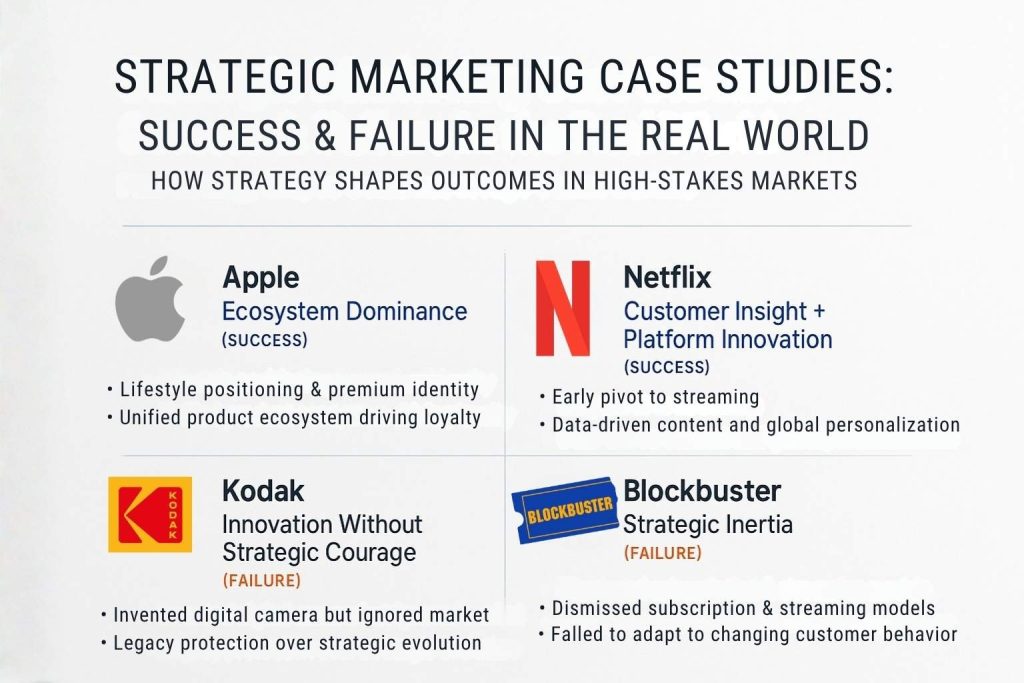
We’ll explore both successes and failures, because each teaches us something about clarity, timing, execution, or adaptability.
Case Study 1: Apple Strategy as Ecosystem Dominance
Let’s start with the gold standard: Apple. Their brand has become a cultural symbol. But this wasn’t an accident or purely a product of great design. It was the outcome of one of the most disciplined and consistent strategic marketing efforts of the past 25 years.
Key Strategic Plays:
- Positioning: Apple positioned itself not as a tech company, but as a lifestyle brand for creative, self-dependent thinkers.
- Ecosystem thinking: By locking value into an integrated system (iPhone, Mac, AirPods, Apple Watch, iCloud), they ensured that customer churn is low and average lifetime value is high.
- Brand discipline: Every touchpoint from packaging to keynote announcements reinforced their premium, minimal, user-centric identity.
Results:
- According to the 2025 Kantar BrandZ ranking found in Business Insider, Apple’s brand value stands at US$1.3 trillion, up ~28 % year‑on‑year.
- Meanwhile, the 2025 Interbrand report values Apple at US$470.9 billion, underscoring the variation in valuation methods.
- The iPhone alone generates over $200 billion in annual revenue, demonstrating the power of strategic consistency.
What We Learn:
Apple’s marketing is strategic because it never chases short-term tactics at the expense of brand coherence. They don’t just sell products; they sell an identity. That’s strategic positioning at work.
Case Study 2: Netflix Customer Insight Meets Platform Innovation
Netflix is often referenced for its disruption of Blockbuster, but its true genius lies in how it used data and technology to continuously adapt its marketing strategy.
Key Strategic Plays:
- Early pivot to streaming: In the early 2000s, while competitors clung to DVD rentals, Netflix shifted toward on-demand digital access.
- Data-driven content: By tracking what customers watch, rewatch, pause, and abandon, Netflix made decisions about what original content to fund.
- Global expansion with local relevance: Netflix didn’t just translate U.S. content. It funded region-specific series like Money Heist and Sacred Games, increasing retention abroad.
Results:
- As of late 2024, according to TheWrap 2024 Netflix surpassed 300 million global subscribers, solidifying its place as the largest streaming service by volume.
- Netflix’s recommendation engine, powered by machine learning, accounts for over 75% of viewer activity, reducing churn and increasing time spent on the platform.
- Annual content investment exceeds $17 billion, but the ROI is visible in engagement, loyalty, and global penetration.
What We Learn:
Strategic marketing is not static. Netflix’s success proves that when you combine customer insight with delivery innovation, you can lead an entire industry transformation. They didn’t just market movies; they engineered viewing behavior.
Case Study 3: Kodak Innovation Without Strategic Courage
Kodak’s story is heartbreaking because they had the tech advantage but refused to make the strategic leap required to maintain relevance.
What Happened:
- Kodak invented the first digital camera in 1975.
- Leadership suppressed the technology to protect the high-margin film business.
- While competitors embraced digital photography, Kodak doubled down on print labs, film sales, and legacy revenue streams.
Fallout:
- By the late 2000s, Kodak lost its consumer relevance.
- According to the Los Angeles Times, in 2012, Kodak filed for Chapter 11 bankruptcy, citing a debt load of $6.75 billion and plummeting revenues.
- Attempts to pivot into digital printing and services came too late to recover consumer trust or market share.
What We Learn:
Strategic marketing requires bravery, especially when a company’s current business model is in conflict with where the market is heading. Kodak failed not because it lacked innovation, but because it lacked strategic will.
Case Study 4: Blockbuster The Cost of Strategic Inertia
Blockbuster’s decline is legendary, but the strategic marketing lessons are often misunderstood. The company had brand equity, customer relationships, and capital. What it lacked was alignment with market behavior.
Strategic Missteps:
- Ignored early signals about streaming and on-demand habits.
- Dismissed Netflix’s subscription model as niche and unsustainable.
- Continued investing in retail expansion and relied on late fee revenue, which was already resented by customers.
Final Nail:
- In 2000, Blockbuster declined an offer to buy Netflix for $50 million, according to a Fortune interview with Netflix co-founder Marc Randolph, who recalled Blockbuster “laughed us out of the room.”
- By 2010, Blockbuster filed for bankruptcy with over $900 million in debt, as reported by Business Insider.
- Netflix, by contrast, was on its way to becoming a global media giant.
What We Learn:
Market leadership is not a moat. Customer behavior evolves, and strategic marketing must be grounded in empathy for future habits, not nostalgia for current models. Ignoring market shifts doesn’t just slow you down; it can ultimately kill the brand.
Final Thoughts: Strategy Is Survival
Strategic marketing is not about frameworks or fancy decks. It operates as part of a broader management discipline that keeps teams aligned around long-term priorities and structured decision-making. It’s about making hard choices: whom to serve, what not to do, and how to outmaneuver inevitable change.
The companies that get this right, like Apple and Netflix, align every decision with their long-term vision, maintain brand coherence, adapt to the market, and execute flawlessly.
Those that fail Kodak, Blockbuster, and many others usually don’t fail because of a lack of intelligence or creativity. They fail because they confuse short-term tactics with strategic direction, or they don’t evolve fast enough to meet the moment.
Marketing, at the highest level, is not about promotion. It’s about positioning for the future.
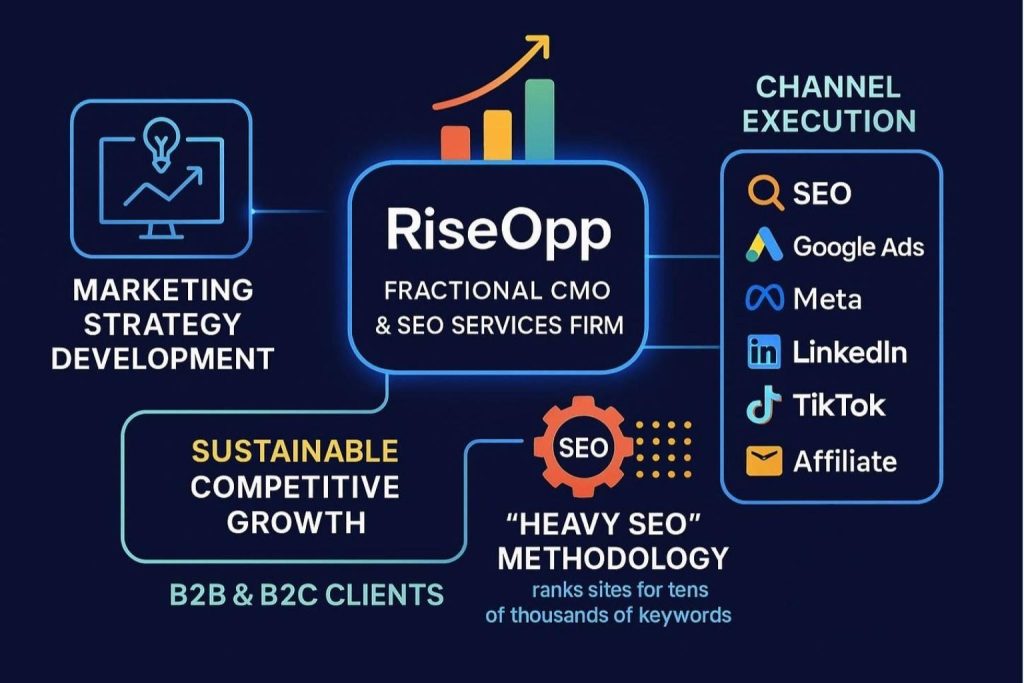
How We Bring Strategic Marketing to Life at RiseOpp
At RiseOpp, we don’t just talk about strategic marketing; we live it. Everything discussed in this article reflects the real-world approach we take as a Fractional CMO and SEO partner to our clients. Whether we’re designing a full-funnel go-to-market strategy, repositioning a brand in a competitive category, or building a demand engine across paid and organic channels, we anchor every move in strategic insight.
Through our proprietary Heavy SEO methodology, we help businesses dominate search across tens of thousands of keywords, not just for vanity traffic, but to drive long-term customer acquisition and compound brand authority. As a Fractional CMO, we guide companies in aligning their marketing initiatives with business goals, building and leading teams, and executing across SEO, Google Ads, Meta, LinkedIn, TikTok, PR, email, and more.
If you’re looking to take your marketing from tactical to transformational, driven by clear strategy, thoughtful execution, and measurable impact, we’d love to be part of that journey.
Let’s talk about how RiseOpp can help your organization implement the kind of strategic marketing that drives real, sustainable growth.
Comments are closed